Thrustmaster have a few flagship products, and when it comes to pedals the T-LCMs are definitely their best on offer. They are one of only two sets of pedals that the company makes, but the T-LCMs are worth thinking about if you are looking to upgrade or switch brands.
The T-LCM pedals from Thrustmaster are a great set of load cell pedals for beginner to intermediate sim racers. They offer lots of realistic feel, while also looking amazing too. They are adjustable, and the customization on offer makes them a truly versatile set of pedals.
There is a lot to talk about with the T-LCM pedals, and below I will go into detail about each aspect of them from a beginner’s point of view. I will discuss how they perform versus other types of pedals, and what to think about when buying sim racing pedals in general.
Things To Think About When Buying Sim Racing Pedals
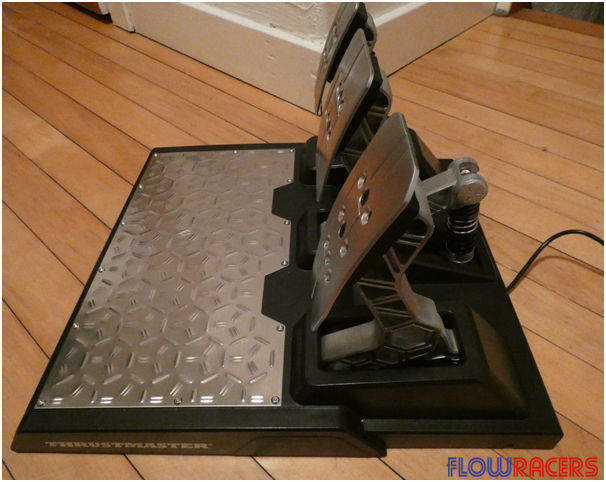
Whether you are looking to buy your first set of sim racing pedals, or if you are upgrading from your current set, there are a few key things to think about before you buy new ones. I won’t go into detail about the specifics too much, as we have a few articles about the specifics of load cell pedals and hydraulic pedals already on the blog.
Go For The Best You Can Afford
But let’s go through a few things to set the scene for the review of the T-LCM pedals. The first thing you might jump to when looking of new pedals for your sim racing rig is the price. This is only something you need to do if you are on a strict budget, as you always want to go for the very best option you can afford, and price is only important when you are trying to choose between 2 sets.
The Mechanism
What really matters is the quality of the pedals themselves. The really important part is the mechanism they use, which at the beginner to intermediate level is either going to be a potentiometer mechanism or a load cell. This is really only important for the brake pedal, with the clutch and accelerator pedals being less dependent on the mechanism used.
How Many Pedals?
You will also probably want a set of three pedals rather than two, as it gives you more versatility with your rig. However, some sets do come in a two-pedal configuration, so be careful when buying. The T-LCM pedals only come in a three-pedal configuration.
Brand And Ecosystem
The brand and ecosystem are an important thing to think about as well. For example, the Thrustmaster ecosystem is vast, and although there are only two pedal sets (with one coming in two configurations) in their catalogue, there are a bunch of wheels and accessories that go along with it. You need to be careful when choosing pedals to ensure they will be compatible with the rest of your rig!
Build Quality
Finally, the build quality of the pedals is important. They need to be made of strong, solid materials to last for a long time. Load cell mechanisms help with this due to the way they work, but the basic construction of the pedals will quickly show if they are high quality or not.
There are other things to consider, such as braking force and customization, but I will touch on these and some other points in the main body of the review below. So, lets get into an overview of the T-LCM pedals.
An Overview Of The T-LCM Pedals
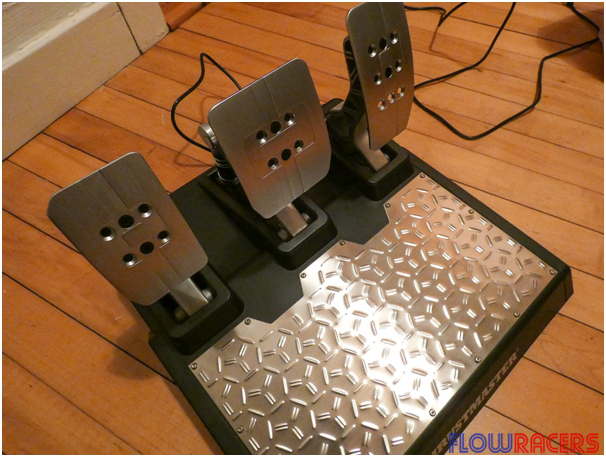
Quite Heavy
When I first took the T-LCM pedals out of the box I noticed that they were substantially heavier than some of the other pedal sets I have owned in the past. They’re pretty big and bulky, and they are a three-pedal set as noted above. Their construction feels solid, with a lot of metal and hard plastic throughout making them feel really high quality.
They use a load cell mechanism for the brake pedal, with the spring for this pedal being adjustable which I will talk more about in the next section. The set can also be calibrated using software, and so there is a lot of customization on offer here. The pedal faces themselves can also be swapped around and adjusted in various different ways too, to suit any playstyle.
A Lot Of Force
The braking force these pedals can take is up to 100kg/200lbs, with the resistance being variable depending on how you set it up with the springs provided. The pedals are built to work within the Thrustmaster ecosystem of wheels and other products, with them connecting to your wheel via an RJ12 connector.
You can also connect it to your PC as a standalone set of pedals through the USB cable provided, and this is also how you can get in and customize the software behind it. While this isn’t essential for the casual use of these pedals, it is worth noting for when you want to really get the most out of the T-LCMs.
Now, let’s get into the good things about these pedals.
What The T-LCM Pedals Do Well
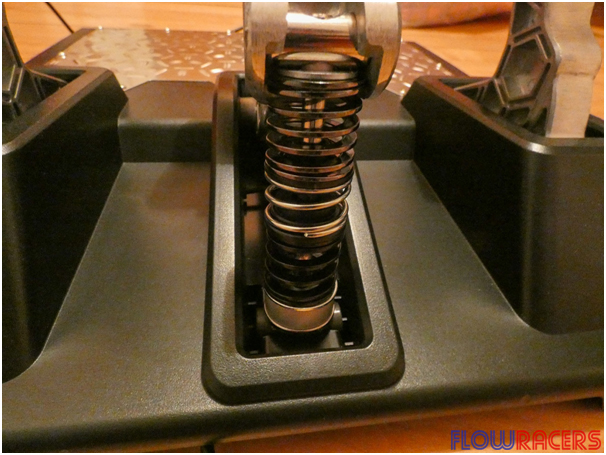
Very Well Made
As noted in the overview, I couldn’t help but notice the overall solid construction of these pedals. They feel heavy, which usually means they are made of high-quality materials, but it also helps keep them planted to the ground, useful under heavy braking. It should be noted that you will still need to have these pedals strapped or screwed down into your rig.
They don’t just feel good as they look great too. You have the metal base that makes them look straight out of a race car, with the pedal faces themselves being made of solid metal too for even more racing realism. The open spring for the brake pedal, while functional, also looks amazing and the pedals just ooze quality.
Lots Of Adjustability
There are three pedals too, which is always a good thing, but even if you don’t use a shifter you can program the clutch in-game to do other things. If you find it gets in the way of your left foot braking, then you can handily move it to various different positions. There are 9 adjustment holes on each pedal, with the height and inclination also being adjustable to suit your preferences.
Moving on from the adjustability of the pedal faces we have the adjustability of the brake pedal, or more importantly the resistance of it. There are 6 springs included with the pedals, varying by different resistance strengths. These can be interchanged with each other to provide a very specific level of resistance.
Changing The Resistance
It should also be noted that you can swap these out extremely easily. All you need to do to change them is push down on the spring at the back of the brake pedal to disconnected it from its slot. Then you just remove the springs and replace them with the ones you want to use, then put them back in place and you’re good to go!
You can then head into the software on your PC by connecting your pedals to it using the supplied USB cable. This is where you can change things like dead zones and braking force, which is ideal for those that want to have even more control over their individual pedal settings. While not essential, and a bit complex for absolute beginners, it is perfect for more advanced racers.
Maximum Control
This really gives you excellent control over your experience with these pedals. But as for how they actually feel to use, I can’t say I am anything but thrilled. I have only used potentiometer pedals in the past, so this was an excellent step up into the intermediate range of sim racing pedals on offer. All three pedals felt really nice to use.
The clutch and gas pedals are not as important as the brake pedal, but it is still great that they are a joy to use as well. You can customize them in the software too, but there isn’t any physical resistance customization on offer for these. The brake pedal however, even on the lowest resistance setting, is just brilliant.
Fine Tune Your Braking
You get a great range of travel and force with the load cell mechanism, and you can really fine tune your braking to get the most out of the car in-game. The pedals use Thrustmaster’s HEART technology, which essentially helps extend their lifetime while also providing a lot of accuracy and realism that definitely shines through even after just a few laps with these pedals.
A final note on their ease-of-use concerns setting them up in your rig. They come with a template sheet that shows you where you would need to line up or drill holes into your rig to accommodate the pedals, which I think is a nice touch. I didn’t need this as I use the Playseat Challenge, which is designed to be a portable solution for a sim racing rig.
Secure Them In Place
These pedals fit well into this, although they did need strapped down pretty tight! Their compatibility with other rigs should therefore be quite straightforward, and there have been no issues so far concerning compatibility with games. I use the PS4 mostly for my sim racing, but they work with PCs as a standalone set as well which further increases their compatibility with other peripherals.
So, there is a lot to love about the T-LCM pedals, but where do they fall short?
Limitations Of The T-LCM Pedals
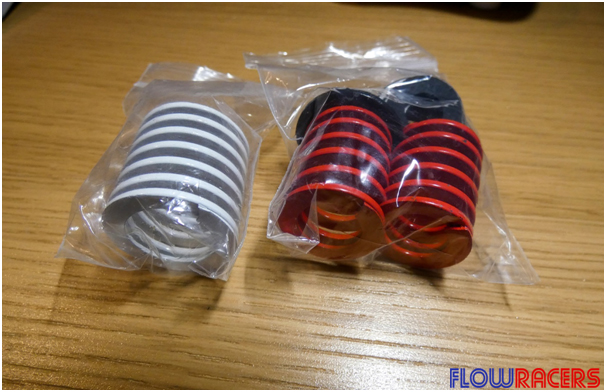
They Can Seem Complex
With all of the customizability and adjustability of these pedals, they can seem a bit complex at first. Being able to program them is great for those that know what they are doing, but if you are a little daunted by all of the options you are definitely not alone. While there is a lot to change with them if you want, the good news is you don’t need to change anything if you’d rather not.
But if you do want to get the most out of these pedals, you will need to learn how to swap out the springs and play around with the software. While this is not necessarily a limitation of the pedals and is just something that comes along with higher end pedals in general, it is worth noting that there is more to just plugging in and playing if you want to really get the most out of them.
Bolt Them Down
The only other real thing to note is that they are quite heavy, but still need properly secured down into your rig. If you are planning to stick these on the floor and get going, it’s just not going to happen. The force you will find yourself putting on these pedals, even on the lowest resistance settings, means that they almost instantly rise up off the ground as you put your foot to the floor.
I actually had to improvise with my Playseat as the strap it came with wasn’t big enough to hold the pedals firmly in place, but if you are screwing these into your rig you won’t have a problem. But this is just something to think about if you are using a makeshift rig or don’t have one at all. Aside from that, these pedals don’t have much going against them!
Who Should Buy The T-LCM Pedals?
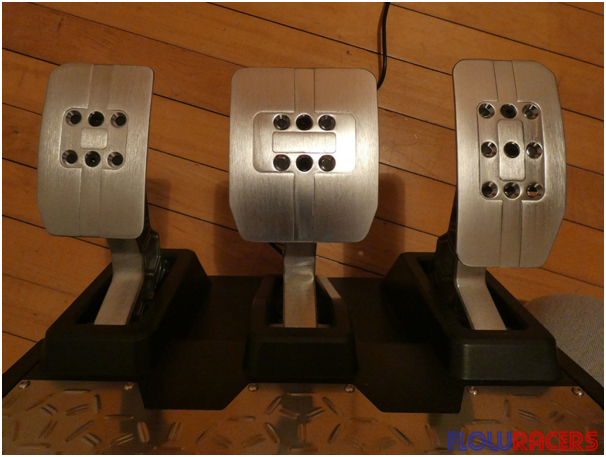
Great For Beginners
So, we’ve gone over the good things about these pedals and the (very few) bad things as well. So, who should buy the T-LCM pedals? Well, I personally think they make an excellent starting point for beginners, even if they are a little complex when it comes to calibration. You don’t need to mess with that side of things if you don’t want to, so you can just enjoy their overall quality until you do.
Excellent For Intermediate Racers Too
For intermediate sim racers I can’t see them being anything but great too. If you are already in the Thrustmaster ecosystem then there really is no reason not to get these pedals, as they are a big step up from any potentiometer sets. Even if you use other wheels like those from Fanatec, as long as you are on PC you will still be able to use these pedals.
I race predominantly on PS4, and these are a brilliant addition to a Thrustmaster wheel such as the T300RS. But if you are a very advanced sim racer and want to get the very best that money can buy, then you may want to look at the options from Fanatec oreven check out hydraulic pedals. While they are much more expensive, they are the pinnacle of sim racing pedals.
Final Thoughts
Overall, the T-LCM pedals from Thrustmaster are a really good option for beginners or anyone looking to upgrade from potentiometer pedals. They look and feel great, while offering plenty of adjustability and customization through the included software. While they are easy to use, they also offer a lot of realism, and an overall excellent feel for any sim racer.
I created and have been writing on this site since 2019, collaborating with drivers, coaches, engineers and manufacturers to provide you with the most reliable information about motorsport. I also make beautiful car posters and track posters.



